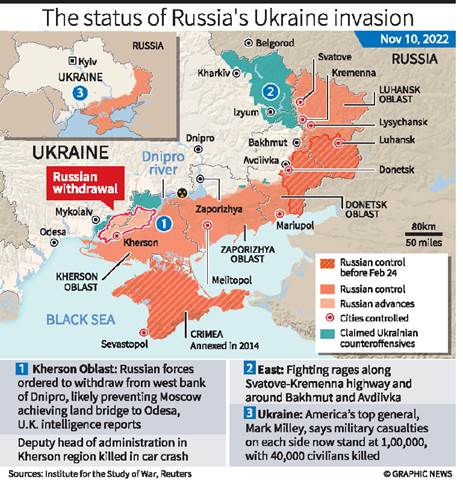RUSSIA’S WITHDRAWAL FROM KHERSON

Copyright infringement is not intended
Context: Ukraine’s defence and intelligence unit has reported on the withdrawal of Russian troops from Kherson but predicts it to be a delusion for a retreat. U.S. President Joe Biden and the EU leaders have termed the withdrawal as a “difficult position” for Russian President Vladimir Putin and condemned the brutality of deporting Ukrainians.
Details:
Where is Kherson and why is it important?
- Geographically, Kherson is a strategic location for Russia and Ukraine. Situated in the northwest of the Dnipro River, the province shares borders with Donetsk, Crimea and the Black Sea.
- With Moscow capturing Crimea in 2014, the occupation of Kherson in March 2022 has benefited Russia in transferring its military from Crimea to counter Ukraine. It provides access to Odesa and Black Sea ports in the west and serves as the main route to secure southern Ukraine.
- For Ukraine, regaining Kherson is significant to protect its population in Kalanchak and Chaplynka districts and also to recapture Crimea. Kherson is also an important region for its agricultural produce, with irrigation channels.
Why has Moscow announced its withdrawal from Kherson?
- First is the mobilisation failure. When Russia was advancing rapidly in capturing the southern and northern cities of Ukraine, its military personnel and weapon systems started to run thin. Russia then pursued a partial mobilisation as the next strategy to circumvent its on-ground limitations. The failure of new recruits added an additional challenge to Russia to keep its hold against the Ukraine counter-offensive in Kherson.
- Secondly, the inability of Russia to govern Kherson. Despite imposing martial law, Russia could not effectively rule Kherson; the three-level security in the occupied areas could not enforce Russia’s control on the ground.
- Third, Ukraine’s expanding counter-offensive. Until August, Ukraine was supplied only with short-range and low-grade weapons by the West. Later, Ukrainian soldiers received military training; as Moscow continued its onslaught, the West upgraded its support with medium to high-range weapons systems such as the Howitzers, HIMARS, air defence systems, battle tanks and drone technologies. It came from the U.S., the U.K. and Germany, whereas Russia’s procurement was slow and limited to Shahed drones. This helped Ukraine recapture Russian-occupied areas including Izyum, northeast, southeast of Kharkiv, Izyum-Slovyansk, Kupiansk in Eastern Ukraine, and northwest Kherson in the south. On the other hand, Russia has been facing challenges in augmenting its military hardware on the battleground.
Is the withdrawal final, or a tactical move by Russia?
- Russia’s new mobilisation has failed to stop the advancing of Ukraine forces. The challenges to remobilise its defence systems and the shortage of weapons must have played a role in Russia’s withdrawal.
- With Ukraine strengthening its military capacity through support from the West, upgrading from land-based to air-based to heavy battle tanks, Russia is facing a challenge to hold its occupied territories in Ukraine.
- However, this is not the first time Moscow is making a withdrawal, after an initial onslaught.
- The attack on Ukraine’s capital Kyiv was an initial strategy of Russia. Later, Moscow shifted its strategy from capturing Kyiv to concentrating on eastern Ukraine. Similarly, Russia also withdrew from its strategy to capture Kharkiv. Controlling Donetsk and Luhansk have become a significant objective.
- Withdrawal from Kherson exposes a serious gap in Russia’s strategy to hold southern Ukraine. However, it also underlines its strategy — to withdraw under serious attack or resistance by the Ukrainian forces — as it happened in Kyiv and Kharkiv.
https://epaper.thehindu.com/ccidist-ws/th/th_delhi/issues/15096/OPS/GBEAGH0PO.1+G0DAGH7C2.1.html




1.png)
